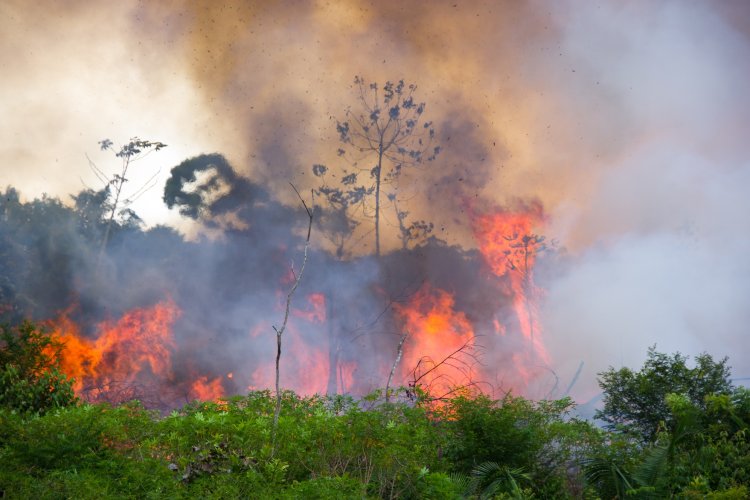Firefighters in Yakutia have put out twice as many wildfires this summer of 2021 compared to the entire last year. Aisen Nikolaev, head of the region, spoke about it. Wildfires in the vast forest areas of the Trans-Urals take place practically every year. Both human negligence and natural disasters become the cause of fires.
It seems easier to prevent fires than to cope with the consequences, but it is still not possible to completely avoid wildfires. The only thing we can do is to make forecasts of their emergence and development in order to take measures in advance and put out the hot spots. Scientists help understand where fires will occur in advance, as well as to prepare the liquids that are more effective than water.
Through Grass, through Crowns, under Ground
There are three types of wildfires: ground fires, crown fires, and underground fires. They differ by the degree of danger, the difficulty of extinguishing them, and the speed of spreading.
Ground fires account for the majority of all wildfires. The fire spreads through grass, forest litter, moss, and lichens. Downwind ground fires in the forest can spread at walking speed, up to 5 kilometers per hour. The flames height depends on the vegetation, for example low shrubs and thin young trees lift the fire up.
If the grass and bushfire has risen up through the trunks to the crowns of trees, reaching the leaves, needles, and branches, a crown fire may start. When the wind is strong, the fire spreads rapidly across the treetops. Gusts of wind cause the flames to “jump” over the crowns, and a crown fire can overtake a fire on the ground. While burning twigs falling from the crowns add new hot spots of ground fire ahead of the main fire.
Underground the fire can spread in peat bogs. Stealthily, at a speed of up to a kilometer a day, the fire can occupy an area far from the original source of ignition. An underground fire burns out roots and causes trees to fall. And a person might fall into burnouts that can reach up to one and a half meters deep.
Understand…
If you understand in advance which forest area has the greatest risk of fire, you can potentially get ahead of the fire. Scientists are developing models and methods that predict danger zones.
The atmospheric-soil measuring complex being developed at Tomsk Polytechnic University records humidity and air temperature, wind speed and direction, rainfall amount, and soil temperature. Based on these data, scientists have proposed using a number of mathematical formulas to assess fire danger, for example, for those situations where a ground fire can develop into a more dangerous crown fire. Such a situation requires special conditions that depend on wind and forest type.
There are also projects aimed at creating a unified system for classifying forest combustible materials. The existing classification systems are descriptive in nature; scientists suggest that a mathematical model is used for physically justified classification of forest combustibles based on their flammability parameters.
…and Pour Down.
Scientists are looking for new, more effective ways to fight wildfires. Most of the methods involve extinguishing fires with water and special liquids.
One of the developments proposes to reduce the time of water evaporation. It is the evaporation of water that mainly reduces the temperature of a fire. In order to achieve this, scientists add various substances, such as carbon nanoparticles, to the water. Due to the lower heat capacity of these substances, the liquid heats up to its evaporation temperature faster.
Firefighters extinguish fires from the sky using airplanes and helicopters. Aerial firefighting methods are about 60 years old. After dropping water on the fire, the plane or helicopter goes to get the next load of water – if the reservoir is far away, the impact of the previous attempt to extinguish may have a minimal effect during the tank refilling. The dumped mass of water does not reach the ground, turning into steam while still in the air. This kind of situation is corrected with the help of substances called wetting agents. The substances that create a thin layer on the burning objects and cut off the oxygen supply are added to the water. It is possible to create a line in a forest fire with wetting agents, which can't be crossed by the fire.
It's great when the weather helps the firefighters. But more often fires occur in dry seasons. At that time, if possible, artificial rainfall is induced over the fire area. A crystallizing reagent is injected into the cloud from an airplane. The rainfall duration depends on the cloud size.
Fire-extinguishing compositions usually have different purposes: wetting agents, blowing agents, fire retardants. However, they also have some disadvantages: for example, blowing agents have no fire-retarding properties, and wetting agents do not provide foam barriers. Scientists from St. Petersburg received a patent for a universal fire-extinguishing composition to fight wildfires. It combines wetting, foam-forming and fire-retarding properties and can be used in the form of solutions of various concentrations or foam.
Despite the new developments and technologies, it is impossible to prevent fires and put them out immediately. Governments calculate financial losses and scientists calculate environmental damage. A Siberia's latest development calculates the carbon emissions from wildfires. The program receives and analyzes data from satellites, including international ones.
Photo: pedarilhos / ru.123rf.com
Based on АAerial Forest Protection Service, TPU, SFU






















